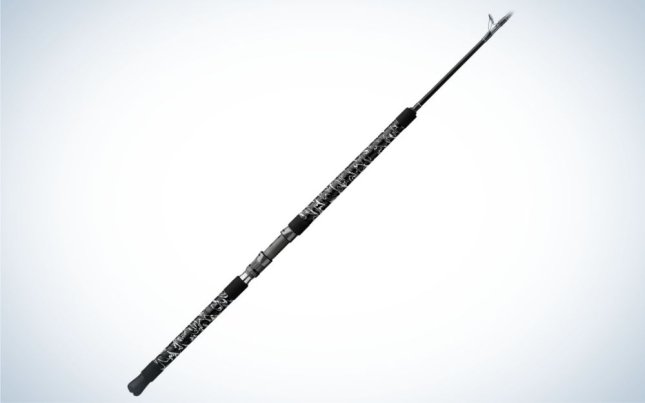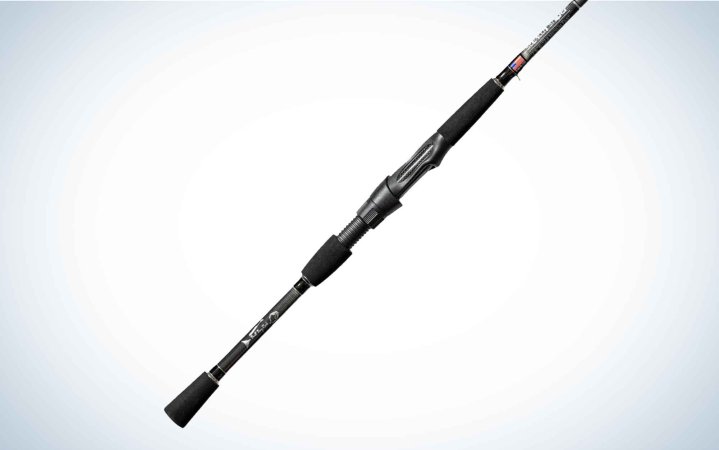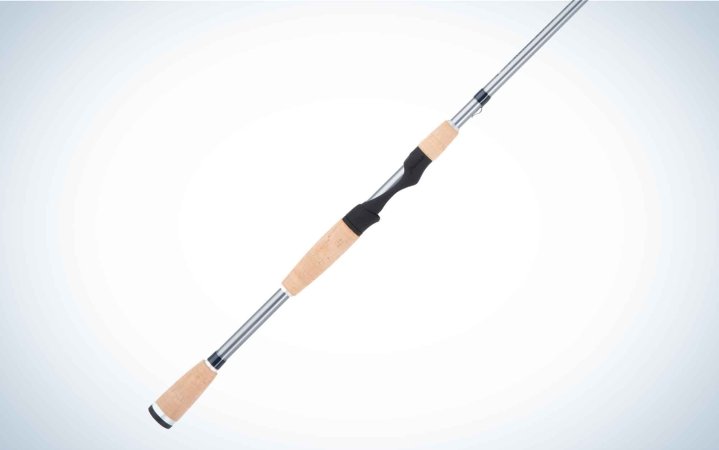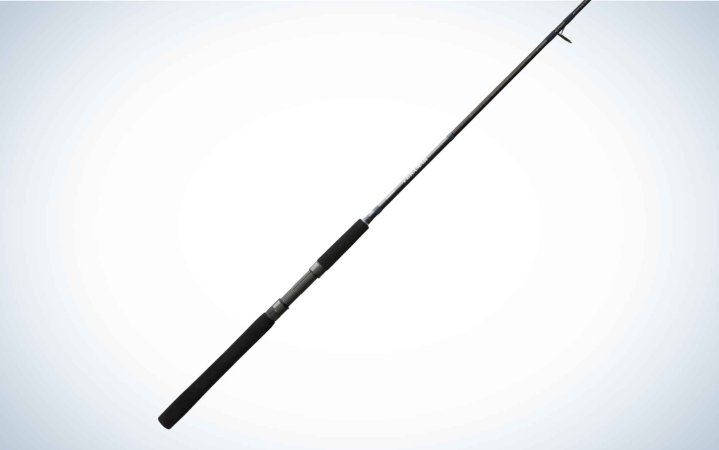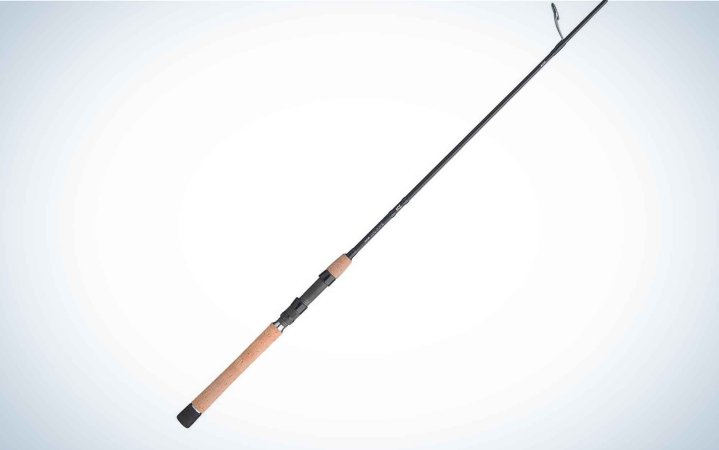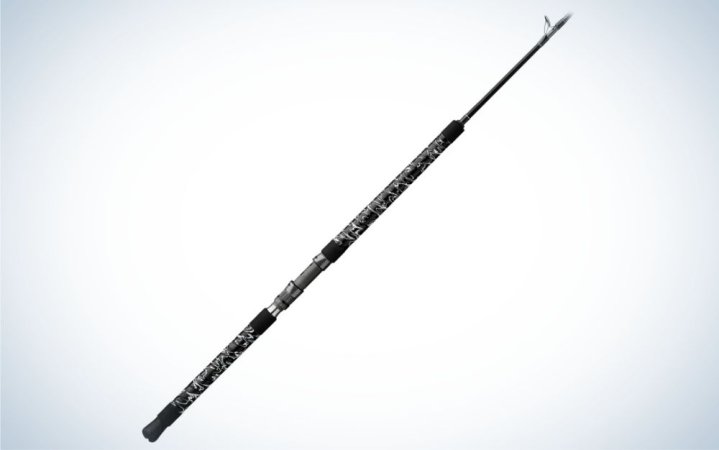We may earn revenue from the products available on this page and participate in affiliate programs. Learn More ›
The best saltwater fishing rods are not only tough enough to survive the rough and tumble world of ocean, bay, and backwater, but are also sensitive enough to detect subtle bites in deep water. Sturdy blanks, corrosion-resistant components, and advanced materials allow saltwater rods to detect the lightest bite and still have the power to beat a pissed-off ocean predator. For this review, I tested the best saltwater fishing rods to see how they performed on the water.
- Best Inshore: Bull Bay Stealth Sniper
- Best Premium: Fenwick World Class
- Best for New England: Shimano Teramar NE
- Best Light/Heavy Crossover: Daiwa Back Bay
- Best Boat Rod: Daiwa Proteus
- Best Jigging: PENN Carnage III Jigging
- Best Surf Rod: St. Croix Seage
- Best Budget: Ugly Stik Bigwater Spinning Rod
How We Chose the Best Saltwater Fishing Rods
To test the best saltwater fishing rods, I spent the past year fishing with the ones on this list. I targeted speckled trout, striped bass, and redfish with the Daiwa Proteus. Then, I trolled for tuna, dolphin, and wahoo with the Shimano Tallus, and when I marked fish deep, I broke out the Carnage III for some jigging. While testing the rods, I took notes on how well components and construction stood up to hard fishing. Cast after cast, drop after drop, I noted how the rods performed in both power and sensitivity. Through this process, I caught lots of fish. All of the rods I tested will work a lure and fight a fish, but they’re also a joy to fish with.
The Best Saltwater Fishing Rods: Reviews and Recommendations
Best Inshore: Bull Bay Stealth Sniper
Pros
- Lightweight
- Impressive backbone
- Excellent casting accuracy and distance
- Reasonable price for elite performance
- Comfortable to cast all day
Cons
- Hard to find in stores
Key Features
- MSRP: $180
- Lengths: 7 and 7.5 foot
- Powers: Medium light, medium, and medium heavy
- Fact action
- Carbon fiber blank
- Tangle free guides
- EVA foam split grip
Tested Rod Specs
- 7 feet, medium
- Weight: 4.6 ounces
- Line Rating: 6 to 12 pounds
- Lure Rating: ¼ to ⅝ ounce
- Butt Length: 8.5 inches

Bull Bay Rods is one of the smaller brands on this list, but don’t let that fool you into thinking they can’t compete with the big names. The Stealth Sniper is the most well-rounded inshore rod we tested, having both finesse and backbone. This rod can cast light jigs a mile with impressive accuracy and has the sensitivity and touch to work small lures precisely. What really separated the Stealth Sniper from the pack was its strength and ability to play large fish that far exceeded its rating. While testing, this rod landed multiple jacks, snook, and black drum up to 40 pounds.
We liked the ultra-comfortable foam split grip that has extended length above the reel seat. The tangle-free guides and well-placed round hook keeper help minimize hassle and line interference when casting.
Overall, the Bull Bay Stealth Sniper was the most complete rod we tested from top to bottom. Its perfect combination of finesse and strength makes it the ideal inshore spinning rod. With a price tag of $180, it’s also significantly less expensive than other comparable rods on this list. When a rod with this level of performance is paired with a price tag like that, it’s hard to deny it the top spot. — Kevin Hughes
Read Next: Best Inshore Spinning Reels
Best Premium: Fenwick World Class
Pros
- Incredibly comfortable to fish
- Handles a wide range of line and lure weights
- Extremely lightweight
Cons
- Expensive
- Poor hook keeper placement
Key Features
- MSRP: $475
- Lengths: 6.5, 7, 7.5, and 8 feet
- Powers: Medium light, medium, medium heavy, heavy, and extra heavy
- Actions: Fast and extra fast
- Spinning and casting rods available
- 40/36 ton graphite blend with reinforcing resin
- Titanium guide frames with zirconia inserts
- Cork and foam grip
- Tangle free guides
Tested Rod Specs
- 7 feet, medium
- Line Rating: 8 to 17 pounds
- Lure Rating: ¼ to 1 ounce
I’ll cut right to the chase; this rod is incredible. In fact, were it not for the exorbitant price tag and a baffling design flaw with the hook keeper, it easily would have been rated as the top rod.
Let’s start with the positives. This rod fishes like no other inshore spinning rod I’ve used. Despite being thicker near the grip than other rods in its class, it’s still incredibly light and casts like a dream. The sensitivity when working small lures was beyond impressive, and the palm fitting design of the grips and reel seat make it one of the most comfortable rods I’ve ever fished.

Much like the Stealth Sniper, the World Class is also astonishingly adept at handling fish much larger than its rating would suggest. It has an almost supernatural ability to subdue fish that would push other rods to the breaking point. It’s hard to describe in words, but this rod lets you connect and direct the fish during a fight in a way that’s unique and impressive.
Now, let’s address the negatives. At nearly $500, it’s at the top end of the market for inshore spinning rods. While you certainly get what you pay for in regard to performance and quality, there’s no denying that it’s a hefty price. Second, and perhaps one of the most confusing design flaws I’ve ever seen, this rod has a rectangular hook keeper placed on the left side of the rod, just above the foregrip.
The shape and placement of the keeper means that, if you aren’t paying attention, your line will loop around the keeper while casting, causing your cast to stall and your lure to fly back at your face. I cannot for the life of me figure out how this element made it on an otherwise almost perfect rod. My best guess is that it’s a vestige of the baitcasting rod design, since the looping problem would be a non-issue with a baitcaster. It’s a small flaw that’s easy to fix with a pair of pliers, but that shouldn’t be the case on a rod this well designed and this expensive.
Hook keeper and price aside, the Fenwick World Class is an absolute dream to fish. No other rod we tested had its combination of feel, strength, comfort, and quality. If you’re comfortable with the cost and don’t mind bending the hook keeper, this rod is the total inshore fishing package and well worth the price. — Kevin Hughes
Best for New England: Shimano Teramar NE
Pros
- Durable
- Excellent for jigging
- Lots of backbone
Cons
- Heavy
- Lacks finesse
Key Features
- MSRP: $230
- Lengths: 6.5 and 7 feet
- Powers: Medium, medium heavy, and heavy
- Actions: Moderate fast, fast, and extra fast
- EVA foam grip
- SeaGuide Zirconia guides
- TC4 Carbon blank
Tested Rod Specs
- 7 feet, medium
- Line Rating: 10 to 20 pounds
What the St. Croix Legend Tournament Inshore is for finesse, the Shimano Teramar NE is for jigging. The NE in the name stands for “Northeast” and it’s easy to see why, as it’s designed specifically for the Northeast style of inshore fishing that typically means casting or vertical jigging heavier jigs and plugs.

When it came to throwing heavier lures, this rod was able to handle the strain of casting while still providing us the sensitivity to work the lures accurately. It was the perfect rod for throwing jigs in the ¼ to 1 ounce range for larger snook and redfish and had an impressive amount of backbone to keep the fish pinned and turn their heads during the fight. The extended EVA foam grip rested nicely under my arm and provided a good amount of torque while playing fish.
This rod is a great example of why it’s important to understand what a rod is built for and how it feels, rather than just relying on specs. The Teramar NE we tested is technically the same size, power, and action as the St. Croix Legend Tournament and the Fenwick World Class. But the three rods couldn’t be more different from a performance perspective. The Teramar NE is the bully of the inshore rods we tested, excelling at sticking large fish and keeping them stuck. While it’s definitely not a rod I’d recommend for finesse applications, you’ll be hard pressed to find a better, lighter rod for putting the hammer on fish around structure or in deeper jigging scenarios. — Kevin Hughes
Best Light/Heavy Crossover: Daiwa Back Bay
Pros
- Well-rounded
- Reasonably priced
- Good casting distance
- Strong backbone
Cons
- Limited lure rating
Key Features
- MSRP: $150
- Lengths: 7 feet, 1 inch; 7.5 feet, and 7 feet, 10 inches
- Powers: Medium, medium heavy, and heavy
- Actions: Fast and extra fast
- Cork grip
- Fuji FazLite tangle free K guides
Tested Rod Specs
- 7.5 foot, medium heavy
- Line Rating: 10 to 20 pounds
- Lure Rating: ⅜ to 1 ounce
The Daiwa Back Bay proved to be a perfect bridge between the light tackle rods and the heavier duty ones. Daiwa markets the Back Bay series as a versatile crossover rod for east coast inshore conditions, and after testing it I firmly agree. I found that the 7-foot, 6-inch, medium-heavy Back Bay had enough sensitivity and finesse to work lighter tackle. The fast action tip was delicate enough to impart subtle movement to jigs and smaller plugs, as well as feel lighter strikes. While this was a pleasant surprise, the rod still performed well as a heavy-duty setup, especially when fighting larger fish.

It was excellent for throwing jigs in the ½ to 1 ounce range and had enough stopping power to turn the heads of larger snook and drum. The tangle free guides and classic cork grip provide a clean casting experience, and the rod itself has the perfect amount of power for ripping long casts with small to medium sized lures. If there are any real drawbacks to the Back Bay, they aren’t immediately noticeable. The biggest issue I see is the lack of a protective coating on the blank, which could lead to significant wear and tear down the line, especially if using this rod in harsher conditions. — Kevin Hughes
Read Next: Best Inshore Spinning Rods
Best Boat Rod: Daiwa Proteus
Best Saltwater Fishing Rod Overall
Pros
- Carbon bias construction
- Fuji back-stop locking reel seat
- Winn grips
Cons
- Winn grips only on select models
Key Features
- Weight: 1 pound
- Material: Graphite
- Line guides: Fuji K guides with aluminum oxide rings
- Conventional rod
Leave it to Daiwa to throw all the latest rod-building advancements into a series of high-quality saltwater rods anyone can afford. When I received a test sample, I had to call Marc Mills, Daiwa’s field marketing manager to explain all the bells and whistles this rod contains. The HFV Nano Plus blank’s design has an incredible weight-to-strength ratio that helps prevent the rod from twisting under pressure. I can feel the result when I’m fighting a big fish instead of fighting the fishing rod. More power is transferred from the rod to the line to help lift the fish and keep the line guides perpendicular to the water when you’ve got a big one hooked. And the blank uses Daiwa’s Braiding X combination of resin and material that makes the rod incredibly strong yet durable.
Daiwa added Fuji’s latest FazLight Tanglefree guides with ceramic center ring for longer casts and less friction. One of my favorite features is Fuji’s back-stop reel seat that uses a lock nut to keep the clamp from loosening while the reel is under pressure. Several Proteus models feature Winn grips which are dense polymer grips that offer more grab and a softer feel while still being tougher than EVA and cork. The Proteus Boat Rod is one of my favorite models, but the series covers inshore and offshore fishing with the same blank technology and the most advanced components.
Read Next: Shimano Nasci: Saltwater Spinning Reel Review
Best Jigging: PENN Carnage III Jigging
Best Jigging Saltwater Rod
Pros
- Durable carbon and fiberglass composite blank
- Responsive and sturdy line guides
- Aluminum gimbal
Cons
- Only available in one size
Key Features
- Weight: 3 pounds
- Material: Graphite and fiberglass
- Line Guides: Fuji K Guides with Alconite inserts
- Spinning rod
Vertical jigging opened up offshore fishing to a new generation of anglers, and PENN’s Carnage III makes the sport even more accessible. Before vertical jigging hit the water, if you wanted to target tuna or wahoo you needed a dozen heavy action trolling rods. Vertical jigging allows you to target the same fish with a single lightweight fishing rod and high-power reel. PENN’s Carnage III Jigging rod is more than up to the test. Even though the Carnage III is one of the more affordable jigging rods, PENN didn’t skimp on the components with Fuji K guides with durable SiC (silicon-carbide) inserts to handle the heat of a big fish.
The weak point on most jigging rods is the reel seat. I’ve seen a pissed off tuna rip a reel right off a jigging rod. But not with the Carnage III’s Fuji graphite and aluminum reel seat. The reel seat is shaped to cup with one hand that provides a comfortable hold while jigging. I’ve also seen tuna yank a jigging rod from an angler’s hand, but PENN gave the Carnage III rubberized shrink-wrapped grips that are durable and sticky even when covered with fish slime and sweat. My favorite feature is the aluminum gimbal, a high quality touch that pays off when the rod is bent double and jammed into a fighting belt. Currently, the Carnage III only comes in one size that’s appropriate for medium-sized tuna and big bottom fish. Still, this rod is an excellent choice for saltwater jigging.
Best Surf Rod: St. Croix Seage
Best Saltwater Fishing Rod for Castability
Pros
- Cool color
- Next-generation carbon fiber compound
- Comfortable Winn fore grip
Cons
- Expensive
Key Features
- Weight: 1.49 pounds
- Material: Carbon fiber
- Line guides: Stainless frame with aluminum oxide eyes
- Spinning rod
For the least friction and the most strength, St. Croix added their stainless steel line guides with slim aluminum oxide rings to their Seage rod. The reel seats are low profile and provide a lightweight feel when holding the reel that reduces fatigue when casting in the surf all day and through the night.
Like all St. Croix rods, the technology comes packaged in a cool-looking rod. The deep, dark blue color really sticks out on a crowded beach. And, the integrated hoods on the reel seat and slim line guides look like they mean business. The shrink wrapped butt and Winn foregrips have a minimalist design, yet they provide maximum traction and a little give for comfort. Cork accents in the butt add a classic look to the modern rod. But the real test comes on the beach when you cast to striped bass or schooling red drum.
St. Croix’s dedication to details became evident when I casted the Seage. On the back cast, I felt the rod loading but not overloading or lagging. And on the cast, the power transferred through the rod like a whip to launch my lure toward the horizon. The stiff and responsive SCII carbon fiber returns to a straight position that reduces friction that might otherwise affect distance and accuracy.
Best Budget: Ugly Stik Bigwater Spinning Rod
Best Budget Saltwater Fishing Rod
Pros
- Affordable
- Durable
- Comfortable padded grips
Cons
- Less sensitive than graphite
Key Features
- Weight: 7 ounces
- Material: Fiberglass
- Guides: One-piece stainless steel
- Spinning rod
This heavy-duty spinning rod has been updated with even tougher components and construction. Ugly Stik swapped their famous unbreakable fiberglass blank with graphite composite to add sensitivity and reduce weight while maintaining durability. The Bigwater adds sturdy, one-piece stainless-steel line guides that don’t have a ceramic insert to break, and the material is corrosion resistant for years of wear-n-tear.
With models from medium to heavy, and lengths from 6 feet, 6 inches to 15-foot long, the Bigwater has a model for everything from casting to trolling to surf fishing. I have a set of Bigwater bottom fishing rods on my boat, and the 7-foot, medium-heavy rods are perfect for dropping an eight-ounce sinker and bottom rig to sea bass and triggerfish. The Bigwater is a great bargain, so I purchased four of them to keep rigged with different bottom rigs that I can just hand to guests who don’t have their own rod. The Bigwater has the backbone to lift a double-header of sea bass off the bottom with a forgiving backbone that absorbs the runs and dives of big bluefish or stubborn shark. These rods are tough, so I don’t worry about banging them around the boat. In fact, Bigwater rods have probably caught more fish than any other rod on my boat.
Things to Consider Before Buying a Saltwater Fishing Rod

After years of fishing saltwater, I’ve seen rods fail, fall apart, snap, and explode. In my experience, the best saltwater rods don’t have to be fancy, cool looking (though this is a plus), or expensive to get the job done. Whether they give the slightest bump of a speckled trout or the explosive strike of a speeding wahoo, the best saltwater fishing rods can suck it up and dish it out. Here are some things to consider before you buy one.
Blank
The blank is a fishing rod’s backbone. It’s the tapered tube of composite fibers that is the foundation for the grips, reel seat, and line guides. First, consider the blank material. Fishing rods are made of fiberglass or graphite, also called carbon fiber. And some rods are made of a combination of materials. In short, fiberglass is cheaper and stronger but less sensitive. Graphite is lighter and more sensitive, but is also more expensive and less durable than fiberglass and is often labeled with weight ratings like 24 ton or 30 ton to indicate the rigidity of the material. A higher number is lighter and stiffer, but also more brittle. I don’t put too much weight into this designation. To me, rod construction is more important than properties of the raw materials, and I haven’t found any correlation between weight numbers and rod quality.
Here are some rules you can follow: A longer blank makes a longer cast, while a shorter blank offers more accuracy and fighting power. Blanks are rated from light to extra heavy weight to match the size of the lure and the size of the target fish. Rods are also rated slow to extra fast to indicate how deep the rod tip bends towards the rod butt. A fast rod only bends at the tip, while a slow rod offers a deeper bend. In general, fast rods are more sensitive and accurate while slow rods provide a longer cast and more fighting power. Finally, a fishing rod is rated by lure weight and line weight. In my experience, this classification is taken with a grain of salt. A ½- to 1-ounce rod may be perfect for a 2-ounce lure and there’s nothing wrong with using 10-pound test line with a rod rated for 20- to 50-pound line.
Line Guides
Line guides are the most important component that affect casting distance and fighting power. They’re also usually the first thing to break. When you cast, the line guide’s job is to collect line as it leaves the reel and direct it out of the rod with the least resistance. To fight a fish, the line guide transfers fighting power from the reel to the fish. The toughest rod guides are single piece stainless steel or titanium. Line guides with a ceramic or composite insert cast farther but seem to break faster. Advanced line guides with ceramic inserts are more sensitive to telegraph every nibble.
Reel Seat and Grips
The reel seat and grips are often overlooked, until a big fish takes off and rips the reel from the rod or pulls the rod from your hands. For light action rods, the reel seat and grips improve sensitivity. In my experience, the best reel seat is light and stiff and even exposes part of the rod blank to feel the slightest bite. The grips are also light and narrow with a comfortable feel for casting all day. On heavy rods, the reel seat and grips prevent a big fish from breaking up the party. Metal or high-impact graphite reel clamps connect the reel securely to the rod.
Feel
When I go rod shopping, I take my reel to the tackle shop. I gather all the rods in the appropriate class, and then I test the weight, balance, and grip of the reel on the rod. In fact, I don’t hesitate to thread the line through the eyes and tie on a lure to test the action. When I think about the hours I’m going to spend with a fishing rod, I put a lot of effort into picking a perfect match. If you can, get your hands on one before you buy it.
FAQs
Saltwater fishing requires a special kind of fishing rod that can handle the harsh salt conditions and the biggest fish. For these requirements, saltwater rods have a more powerful action that’s capable of lifting heavy weight, and they come in sizes from medium-action light-tackle rods to heavy-duty trolling rods aimed at catching the biggest fish in the sea. The key is to match the rod to the weight of your lure or bait and the size of the fish you intend to target.
Freshwater rods have lighter-action and lighter weight than saltwater rods, because freshwater fish tend to be smaller, and they don’t need the sturdy, corrosion resistant components required by saltwater rods.
However, in recent years, many features, like light weight and action, of freshwater rods have been copied in saltwater models. More saltwater anglers are using low-profile, baitcasting rods to target inshore fish from redfish to cobia and yellowtail.
Saltwater rods range in price from under $100 to over $1,000. Typically, a less expensive fishing rod is often heavier and less sensitive than a similar rod that’s more expensive. All saltwater fishing rods use corrosion-resistant components, but higher-priced models have a lighter blank, line guides and reel seat. Cheaper rods use foam grips that are subject to dry rot and damage while a more expensive rod employs tougher heat-shrink or cork grips. And good looks don’t come cheap, fancy wraps and silky finishes add significantly to the cost of the best saltwater fishing rods.
The biggest difference is casting distance, accuracy, fighting power, and sensitivity. Squeezing every ounce of performance out of a high-quality rod blank requires advanced materials and construction, which doesn’t come cheap. Spending more on a fishing rod may not result in catching more or bigger fish, but a nice rod does make fishing more fun.
Final Thoughts
No matter what type of saltwater fishing you plan on doing, there are plenty of options for different scenarios and budgets. Consider how you’ll spend most of your time fishing, and choose the best saltwater rods that work best for you. If you can, get your hands on a few different ones to try them before you buy them.

